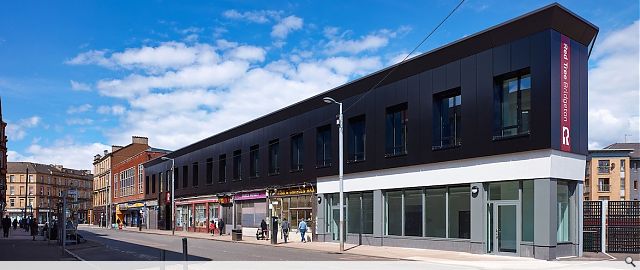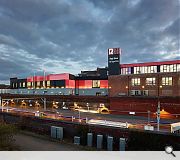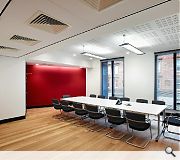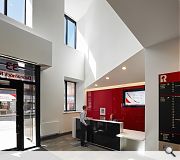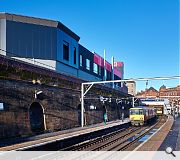Red Tree Business Centre
Red Tree Business Centre Bridgeton is situated at Bridgeton Cross and creates an innovative and vibrant office building for SME companies at the heart of Bridgeton Town Centre at an important gateway into the city of Glasgow. The once largely derelict property now provides 1,650 m2 office and retail space for up to 28 SMEs. It was completed in March 2013, is now 50 % let, and has brought 38 new jobs to the town centre.
The buildings form a significant street frontage to Dalmarnock Road to the south, and is visually prominent from both London Road and Bridgeton Railway Station to the north. The poor visual condition of the buildings viewed from these two key transport routes into Glasgow created a negative impression of the area hindering economic development.
Sustainable economic and physical regeneration of the two adjacent buildings as part of wider plans in the area was the main key objective of the project for Clyde Gateway. Achieving this with a high quality and sustainable building and creating jobs in the area though the development of the building as a business centre were the next key objectives.
An early appraisal explored several strategic options including demolition and new build. However due to several key factors including the costs and risks involved in demolition and re-building so close to the railway station; the successfully operating local businesses at street level and the flexibility offered by the existing concrete frame construction the case was made for retrofitting.
The upper stories of the existing buildings have been developed into high specification offices with significant structural alterations internally to provide attractive and legible internal circulation. The introduction of a linear, black form framing the shop units below creates a strong regulated facade back to Dalmarnock Road.
The differing floor levels of the two buildings and ceiling heights combined with varying depth of plan along the site was highly compatible with the brief to create a variety of office sizes that are proving to appeal to a wider range of tenants than a more regulated new build office might.
An upper quartile EPC was sought with the building achieving a B+ rating upon completion which is considered very good for a refurbishment project. This was achieved through high levels of fabric insulation, the maximization of natural ventilation where-ever possible, a small solar thermal array, good building management control systems and intelligent lighting all help to reduce the energy use of the building.
The highly visible rear elevation was identified as a key elevation at an early stage by both client/design team and local community due to it’s visual prominence from the railway station and key transport route of London Road. The largely blank elevation (forming the rear of the existing shops) has been carefully balanced with the introduction of a lighting installation and a carefully commissioned art work.
Internationally renowned artist Toby Paterson, developed a graphical treatment that relates to the local area’s history of weaving and dying, whilst taking into account the context of red brick and salmon sandstone tenements. The aim was to create a facade that both harmonises with the neighbouring buildings and context but at the same time creates a strong individual presence for the building within the regeneration of the East End of Glasgow.
Currently the building is 50% let, which is significantly ahead of target, bringing 38 new jobs to the area. Throughout the development and construction process the existing successful local businesses at ground floor have all been retained in tact and remained in business. Post completion and as a direct result of the refurbishment of the offices above, several shop units are in the process of upgrading their shopfronts, some for the first time in 30 years, with financial assistance from Clyde Gateway URC, which further enhances the physical regeneration of the area. Two new shops have been provided in the redevelopment which have now both been let to businesses new to the area.
The redevelopment of these buildings as part of Clyde Gateway’s larger regeneration project in the East End if Glasgow has rejuvenated this locally significant part of Bridgeton and is already acting as a catalyst for further physical and economic regeneration in the area.
The buildings form a significant street frontage to Dalmarnock Road to the south, and is visually prominent from both London Road and Bridgeton Railway Station to the north. The poor visual condition of the buildings viewed from these two key transport routes into Glasgow created a negative impression of the area hindering economic development.
Sustainable economic and physical regeneration of the two adjacent buildings as part of wider plans in the area was the main key objective of the project for Clyde Gateway. Achieving this with a high quality and sustainable building and creating jobs in the area though the development of the building as a business centre were the next key objectives.
An early appraisal explored several strategic options including demolition and new build. However due to several key factors including the costs and risks involved in demolition and re-building so close to the railway station; the successfully operating local businesses at street level and the flexibility offered by the existing concrete frame construction the case was made for retrofitting.
The upper stories of the existing buildings have been developed into high specification offices with significant structural alterations internally to provide attractive and legible internal circulation. The introduction of a linear, black form framing the shop units below creates a strong regulated facade back to Dalmarnock Road.
The differing floor levels of the two buildings and ceiling heights combined with varying depth of plan along the site was highly compatible with the brief to create a variety of office sizes that are proving to appeal to a wider range of tenants than a more regulated new build office might.
An upper quartile EPC was sought with the building achieving a B+ rating upon completion which is considered very good for a refurbishment project. This was achieved through high levels of fabric insulation, the maximization of natural ventilation where-ever possible, a small solar thermal array, good building management control systems and intelligent lighting all help to reduce the energy use of the building.
The highly visible rear elevation was identified as a key elevation at an early stage by both client/design team and local community due to it’s visual prominence from the railway station and key transport route of London Road. The largely blank elevation (forming the rear of the existing shops) has been carefully balanced with the introduction of a lighting installation and a carefully commissioned art work.
Internationally renowned artist Toby Paterson, developed a graphical treatment that relates to the local area’s history of weaving and dying, whilst taking into account the context of red brick and salmon sandstone tenements. The aim was to create a facade that both harmonises with the neighbouring buildings and context but at the same time creates a strong individual presence for the building within the regeneration of the East End of Glasgow.
Currently the building is 50% let, which is significantly ahead of target, bringing 38 new jobs to the area. Throughout the development and construction process the existing successful local businesses at ground floor have all been retained in tact and remained in business. Post completion and as a direct result of the refurbishment of the offices above, several shop units are in the process of upgrading their shopfronts, some for the first time in 30 years, with financial assistance from Clyde Gateway URC, which further enhances the physical regeneration of the area. Two new shops have been provided in the redevelopment which have now both been let to businesses new to the area.
The redevelopment of these buildings as part of Clyde Gateway’s larger regeneration project in the East End if Glasgow has rejuvenated this locally significant part of Bridgeton and is already acting as a catalyst for further physical and economic regeneration in the area.
PROJECT:
Red Tree Business Centre
LOCATION:
Bridgeton, Glasgow
CLIENT:
Clyde Gateway
ARCHITECT:
Collective Architecture
Suppliers:
Main Contractor:
Clark Contracts
Photographer:
Andrew Lee (exterior)
Photographer:
McAteer Photography (interior)
Back to Retail/Commercial/Industrial
Browse by Category
Building Archive
- Buildings Archive 2024
- Buildings Archive 2023
- Buildings Archive 2022
- Buildings Archive 2021
- Buildings Archive 2020
- Buildings Archive 2019
- Buildings Archive 2018
- Buildings Archive 2017
- Buildings Archive 2016
- Buildings Archive 2015
- Buildings Archive 2014
- Buildings Archive 2013
- Buildings Archive 2012
- Buildings Archive 2011
- Buildings Archive 2010
- Buildings Archive 2009
- Buildings Archive 2008
- Buildings Archive 2007
- Buildings Archive 2006
Submit
Search
Features & Reports
For more information from the industry visit our Features & Reports section.


